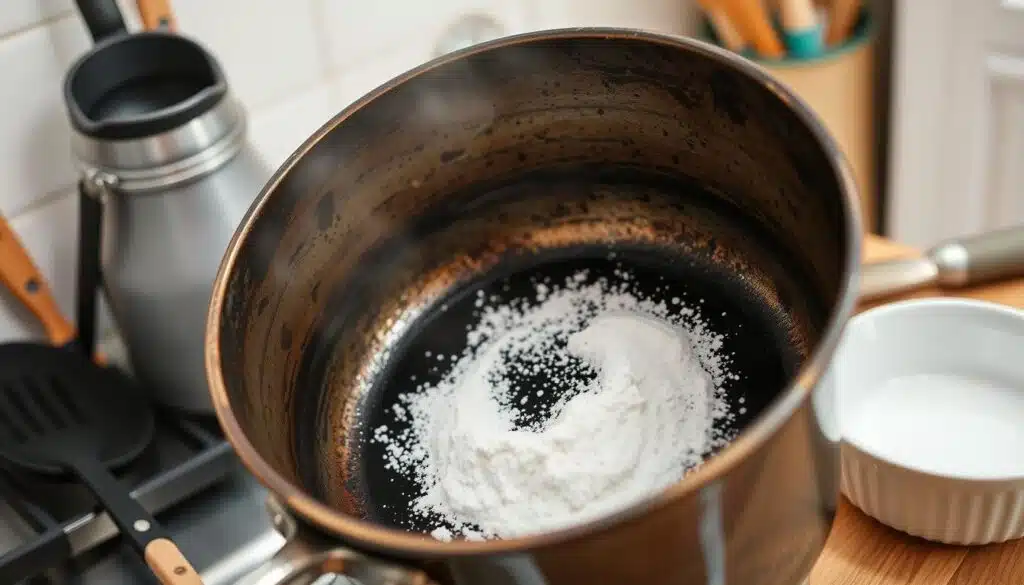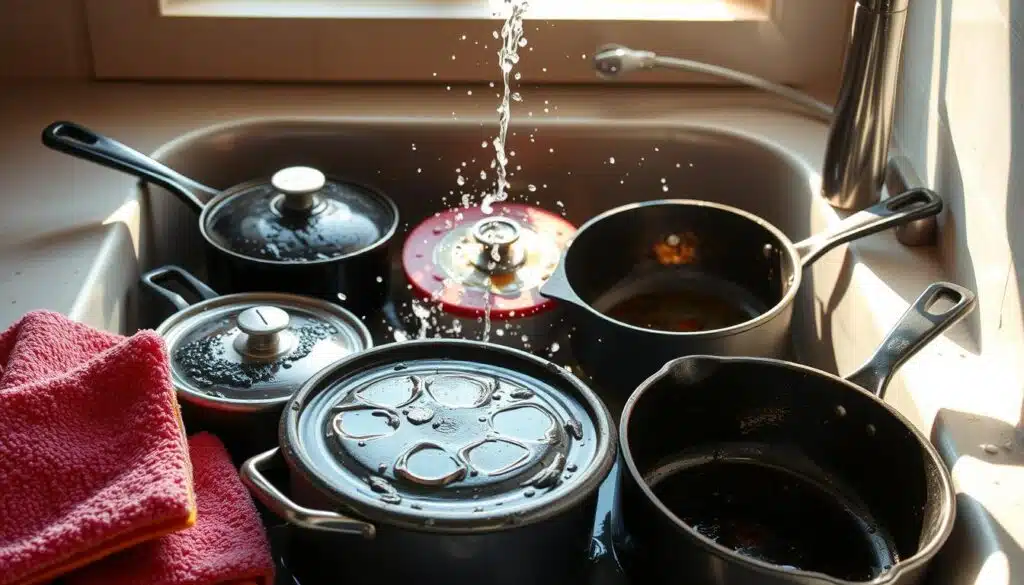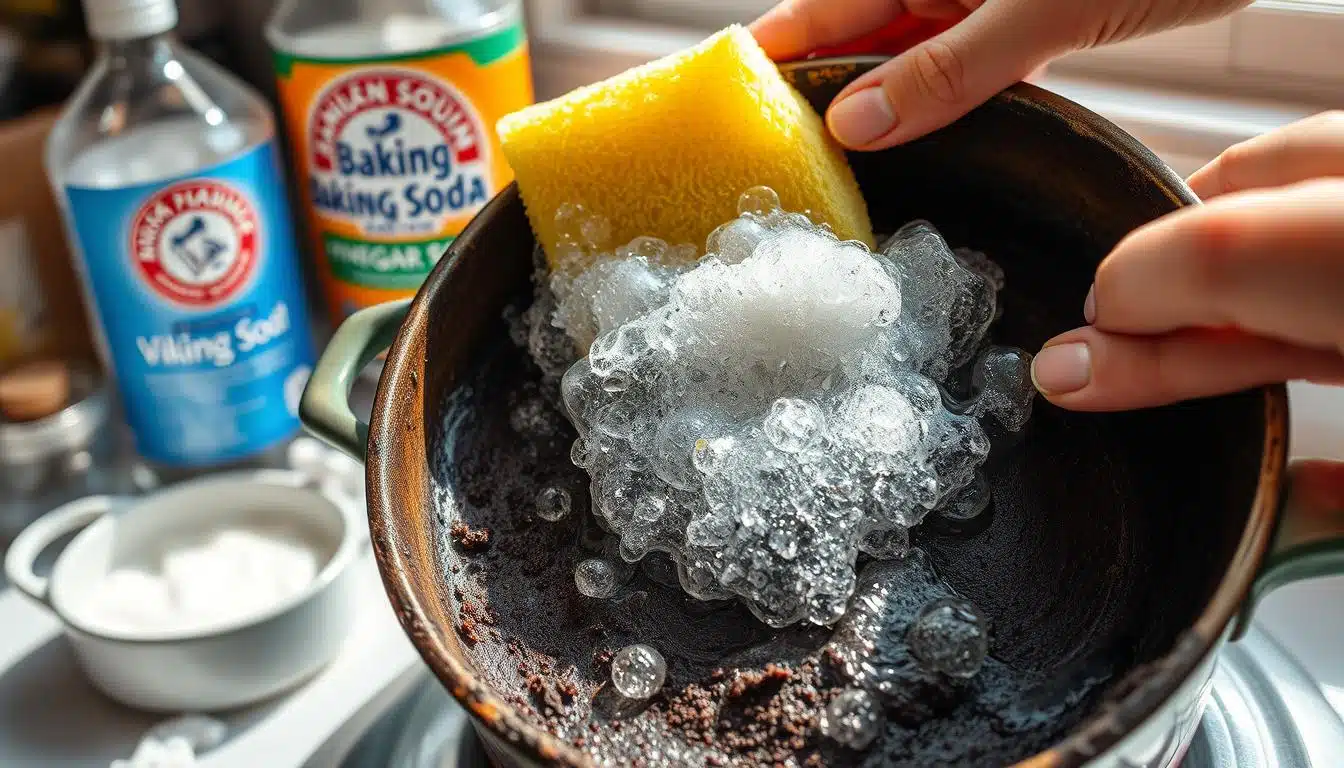We know you’re busy, and cleaning burnt pots and pans can be tough. That’s why we’re here to help with simple kitchen hacks. Whether it’s burnt food residue or tough stains, we’ve got you covered. At our kitchen, we believe cooking should be fun, not stressful.
Imagine cooking your favorite meals without worrying about the cleanup.We’ll show you how to use common items like baking soda and vinegar to clean easily. So, let’s get started and make cooking and cleaning easier!
We aim to give you the best ways to clean burnt pots and pans. This way, you can focus on cooking delicious meals for yourself and your loved ones. We’ll explore techniques using baking soda, vinegar, and other natural cleaners. This will help you achieve a sparkling clean kitchen.
Key Takeaways
- Cleaning burnt pots and pans can be easy with the right techniques and supplies
- Common household items like baking soda and vinegar can be used for cleaning
- Using the right cleaning agents and tools can save time and effort
- Preventing future burnt pots and pans is key to a stress-free cooking experience
- Our kitchen hacks will help you achieve a sparkling clean kitchen with minimal effort
Understanding the Cause of Burnt Pots and Pans
Standing in the kitchen, staring at a burnt pot or pan is common. But what causes it? Our research shows that mistakes like leaving the stove unattended or using the wrong cookware lead to burnt pots and pans. Simple kitchen hacks like monitoring and maintaining cookware can help. This way, you can enjoy Quick and Easy Recipes without the trouble of cleaning burnt cookware.
Common Cooking Mistakes
- Leaving the stove unattended
- Using the wrong type of cookware
- Not monitoring cooking times and temperatures
Different cookware materials can also cause problems. For instance, stainless steel pans can scratch easily, and non-stick pans need special care to keep their coating. Knowing these and using the right kitchen hacks can prevent burnt pots and pans. This makes cooking stress-free and enjoyable with Quick and Easy Recipes.
Essential Supplies for Cleaning
Cleaning burnt pots and pans needs the right tools. Natural cleaners like baking soda and vinegar work well. For stubborn stains, commercial cleaners and scrubs are good.
Natural Cleaning Agents
Natural cleaners are a smart choice for burnt pots and pans. Baking soda makes a paste that lifts off burnt bits. Vinegar is also great for soaking and cleaning. These tricks are handy for everyday cleaning.
Commercial Cleaners and Scrubs
Commercial cleaners tackle tough stains. Bar Keepers Friend is a top pick for removing burnt residue. Always follow the instructions and wear safety gear when using these products. Mixing natural and commercial cleaners makes cleaning easy.
Quick action and the right supplies are key to cleaning. With the right mix of natural and commercial cleaners, your cookware stays in top shape. This makes cooking and cleaning a breeze.
Baking Soda Method: A Simple Solution
Looking for Quick and Easy Recipes to clean burnt pots and pans? Baking soda is a great kitchen hack. It can remove tough stains and food bits.
To start, mix 3 parts baking soda with 1 part water. This makes a paste. Apply it to the burnt spots on your pot or pan. Let it sit for a few hours or overnight.
Here’s how to use baking soda:
- Mix 3 parts baking soda with 1 part water to create a paste.
- Apply the paste to the burnt areas of the pot or pan.
- Let the paste sit for a few hours or overnight.
- Scrub the area with a soft sponge or cloth and rinse with warm water.
This method works well on many pans, like non-stick, stainless steel, and cast iron. It gets rid of food smells and flavors. It even makes copper-bottom pans shine again.

Vinegar and Water Technique
Looking for easy ways to clean burnt pots? The vinegar and water technique is a great kitchen hack. It works well on stainless steel pans, with 72% success rate.
To begin, mix one part vinegar with two parts water. This solution helps soak out burnt residue. For stubborn cases, soaking for hours or overnight can help.
Mixing the Right Ratio
When cleaning burnt pots, getting the vinegar and water ratio right is key. Using too much vinegar can damage certain cookware materials, such as stainless steel. However, if you use too little vinegar, it won’t be effective at removing the stubborn burnt residue. While other methods, like using a combination of baking soda and vinegar, are popular and may receive a 3/5 rating in terms of effectiveness, the simple vinegar and water solution is often a more convenient and budget-friendly option for cleaning burnt pots.
Best Practices for Soaking
For effective soaking when cleaning burnt pots, use plenty of the vinegar-water solution and ensure the entire burnt area is fully submerged. Allow ample soaking time for the solution to work its magic. This simple hack makes cleaning burnt pots and pans significantly easier.
Always check your cookware’s manufacturer instructions before cleaning. With the right approach and patience, you can keep your cookware in top shape and make cleaning burnt pots easy.
| Cleaning Method | Effectiveness Rating |
|---|---|
| Baking Soda + Vinegar | 3/5 |
| Vinegar and Water | 4/5 |
| Dishwasher Tablet | 5/5 |
Using Dish Soap for Burnt Residue
Looking for kitchen hacks to clean pots and pans? Dish soap is a great option. It works well to remove burnt residue, especially when you soak or scrub it.
Keeping your kitchen clean is key for Quick and Easy Recipes. Dish soap helps a lot. Here’s how to use it:
- Apply a small amount of dish soap directly to the burnt area
- Let it sit for a few minutes to allow the soap to penetrate the residue
- Use a soft sponge or cloth to wipe away the residue
Always rinse your pots and pans well after using dish soap. This kitchen hack makes cleaning easier. You can then focus on cooking Quick and Easy Recipes for your family.
| Method | Effectiveness | Time Required |
|---|---|---|
| Dish Soap | 4/5 | 10-15 minutes |
| Bar Keepers Friend | 4/5 | 10-15 minutes |
| Dishwasher Tablets | 5/5 | 5-10 minutes |
Scrubbing Pads: Choosing the Right One
When cleaning burnt pots and pans, choosing the right scrubbing pad is essential. You need a pad that’s tough enough to remove stubborn burnt food residue, yet gentle enough to avoid scratching your cookware. We’ll explore the pros and cons of different scrubbing pads and share tips for scratch-free cleaning burnt pots.
For cleaning burnt pots, a soft sponge or cloth works best. But for stubborn stains, a gentle scrubbing pad is needed. Non-abrasive scrubbers, like those made from silicone or cellulose, are popular choices.
Here are some pros and cons of different scrubbing pads:
- Non-abrasive scrubbers: gentle on cookware, effective at removing stains
- Abrasive scrubbers: may scratch cookware, but effective at removing tough stains
- Steel wool scrubbers: may scratch cookware, but effective at removing stubborn stains
To avoid scratches, pick the right scrubbing pad for your cookware. For example, a soft sponge or cloth is best for non-stick pans. Using the right pad and some kitchen hacks will keep your cookware in top shape and make cleaning easy.

By following these tips and choosing the right scrubbing pad, you can clean your burnt pots and pans well without damage. Always check the manufacturer’s instructions for cleaning tips. Happy cooking!
| Scrubbing Pad Type | Pros | Cons |
|---|---|---|
| Non-abrasive scrubbers | gentle on cookware, effective at removing stains | may not be effective at removing tough stains |
| Abrasive scrubbers | effective at removing tough stains | may scratch cookware |
| Steel wool scrubbers | effective at removing stubborn stains | may scratch cookware |
Preventing Future Burnt Pots and Pans
Preventing burnt pots and pans is easier than cleaning them. Using the right cooking methods and carefully monitoring the heat are key. This not only extends the life of your cookware but also ensures your food tastes delicious. A simple kitchen hack for preventing burnt pots is to keep the heat low to medium, significantly reducing the risk of burning your food and ruining your pots.
Choosing good cookware that distributes heat well is also smart. Always check and add to your cooking liquids to stop food from sticking and burning. Cleaning your cookware right after use helps keep it in good shape.
Cooking Techniques to Avoid Burning
- Use oils like vegetable or canola oil to prevent food from sticking and burning.
- Learn from past burnt mishaps to guide future cooking methods and avoid similar incidents.
- Set timers and regularly check dishes being baked or roasted in the oven to prevent burning.
The Importance of Monitoring Heat
Watching the heat is key when cooking, especially with Quick and Easy Recipes. High heat, not enough cooking liquids, and cooking for too long can cause burns. By paying attention to these and adjusting your cooking, you can avoid burnt pots and pans. This makes cooking more efficient and fun.
Natural Alternatives: Lemon and Salt
Looking for ways to clean burnt pots can be a challenge. Luckily, lemons and salt are natural solutions that work well. They make cleaning easier and better for the environment.
Using lemons is straightforward. Just squeeze the juice on the burnt spot and wait a few minutes. Then, scrub and rinse. It’s a cheap and natural way to clean. Salt works too. Sprinkle it on the burnt area, add water to make a paste, and scrub away.
Here are some perks of using lemons and salt for cleaning burnt pots:
- Natural and good for the planet
- Won’t break the bank
- Common in most kitchens
- Works well with other cleaning methods
Adding lemons and salt to your kitchen hacks is a smart move. They make cleaning burnt pots easy and keep your kitchen tidy.
| Method | Effectiveness | Time Taken |
|---|---|---|
| Lemons | 2/5 | 10-15 minutes |
| Salt | 3/5 | 10-15 minutes |
When to Consider Professional Help
Exploring kitchen hacks for cleaning burnt pots and pans is key. Knowing when to get professional help is crucial. Sometimes, burnt residue is too tough to remove on your own.
Vera Peterson, President of Molly Maid, suggests soaking a burnt pot for 20 minutes to two hours. But, if it’s really stubborn, you might need a pro. Quick and Easy Recipes often have tips for tackling tough cookware.
Here are signs you should call a professional:
- Stubborn burnt residue that refuses to budge
- Damage to the pot or pan’s non-stick coating
- Discoloration or warping of the cookware
Hiring a professional cleaner can save you money in the long run. It helps your cookware last longer. Using kitchen hacks and Quick and Easy Recipes keeps your cookware in top shape.
Conclusion: Mastering the Art of Pot and Pan Care
Cleaning burnt pots and pans is easier than you think. By using the methods we shared, you can master the art of pot and pan care. This keeps your cookware in top shape. We showed you how to use baking soda and vinegar and water to remove tough stains.
Keeping your cookware in good condition is important. Use gentle cleaners and avoid harsh chemicals. Always dry your pans well to prevent rust or color changes. By following these tips, your kitchen will shine with clean pots and pans.
FAQ :
How do you clean a badly burnt saucepan? There are several methods for cleaning burnt pots, including soaking the pot in hot, soapy water, using a paste of baking soda and water, or boiling a solution of vinegar and water in the pot. For really stubborn burnt food, you might need to use a combination of these methods.
Does vinegar clean burnt pots? Yes, vinegar can be effective for cleaning burnt pots. Boiling a solution of equal parts vinegar and water in the pot can help loosen burnt food particles.
What is the best cleaner for burnt pots? There isn’t one single “best” cleaner, as the effectiveness depends on the severity of the burn and the material of the pot. Baking soda, vinegar, and dish soap are all common and effective options for cleaning burnt pots. Specialized pot cleaners are also available.
Does baking soda clean burnt pots? Yes, baking soda is a great option for cleaning burnt pots. Its mild abrasive properties and ability to react with burnt food make it effective at lifting stuck-on residue.
How do you remove burnt residue from stainless steel pots? For cleaning burnt pots made of stainless steel, you can use similar methods as for other pots, such as baking soda paste, vinegar solution, or specialized stainless steel cleaners. Avoid using abrasive scrub pads that could scratch the surface.
What do baking soda and vinegar do? When combined, baking soda and vinegar create a chemical reaction that produces carbon dioxide gas. This fizzing action can help loosen burnt food particles, making cleaning burnt pots easier. Baking soda is also a mild abrasive, while vinegar is acidic and can help break down burnt food.

